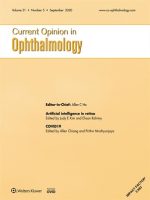In this study, Dr. Aaron Lee, Dr. Cecilia Lee and their co-authors used a unique artificial intelligence approach for identifying novel anatomic biomarkers in the retinas of patients with age-related macular degeneration. Patients with this condition can progressively lose their central vision, and there are still no effective treatments for the more common dry (non exudative) form of the disease. Delayed rod-mediated dark adaptation is the method through which the retina recovers after a stimulus of bright light, and this process can be measured as a function of time to help predict which patients are at risk for age-related macular degeneration and vision loss. The authors wanted to take advantage of the increasingly advanced retinal imaging technology available to search for structural changes in the retina that might be associated with dark adaptation dysfunction, to better understand the cellular and structural pathology that occurs early the in age-related macular degeneration disease process.
Continue reading "Exploring a Structural Basis for Delayed Rod-Mediated Dark Adaptation in Age-Related Macular Degeneration Via Deep Learning"Minimum data set for SD‐OCT retinal imaging and analysis from the Atlas of Retinal Imaging in Alzheimer's Study
In this article, a group of authors representing 16 different institutions (including our own Dr. Cecilia Lee) have laid out a framework for standardization of retinal imaging data collection for Alzheimer's disease biomarker research studies. Many labs are doing research in this area, but they often use different imaging modalities and protocols, making it challenging to compare data between studies. Because these studies often have small numbers of subjects by necessity, standardizing data collection will also enable researchers to collect data into a larger database, allowing them to observe larger trends in the data.
Continue reading "Minimum data set for SD‐OCT retinal imaging and analysis from the Atlas of Retinal Imaging in Alzheimer's Study"Retinal Biomarkers of Alzheimer's Disease
In this perspective article for the American Journal of Ophthalmology, Dr. Lee and Dr. Apte summarize the current understanding of retinal changes associated with Alzheimer's disease that have been identified thanks to recent advances in imaging technology. Some of these imaging findings correlate with known pathologic findings, and some are associated with cognitive decline. The authors discuss the current understanding of how these retinal changes may be related to neurodegeneration or other AD-related brain pathology on a cellular level.
The eye offers a unique window into the brain, as the neurons in the eye are a direct extension of the central nervous system and share the same embryonic development. Researchers have known for decades that optic nerve degeneration, the loss of retinal ganglion cells, and thinning of the retinal nerve fiber layer are associated with Alzheimer's disease based on pathological examination of post-mortem eyes, but recent developments in imaging technologies such as optical coherence tomography (OCT) allow physicians to easily assess these changes during a regular eye exam. New imaging techniques have also led to the discovery of new retinal biomarkers.
Continue reading "Retinal Biomarkers of Alzheimer's Disease"Big data requirements for artificial intelligence
In this article for the journal Current Opinion in Ophthalmology, Dr. Wang and her co-authors discuss the evolution of big data and artificial intelligence technologies in medicine, and describe some of the problems that must be addressed for big data to successfully enable the next generation of artificial intelligence.
Big data research has benefitted from important technological advances in recent years. Artificial intelligence research depends on large amounts of data, often collected from multiple institutions, in order to be most effective. More powerful computing resources, implementation of electronic health records, improved data collection, and efforts to create standards for data exchange have all helped researchers aggregate larger datasets. But there are still some important limitations to accessing big data for this kind of research, which the authors discuss in detail.
Continue reading "Big data requirements for artificial intelligence"Protecting Data Privacy in the Age of AI-Enabled Ophthalmology
In this commentary in the journal Translational Vision Science and Technology, Dr. Elysse Tom and her co-authors discuss digital data privacy in the era of "Big Data" and artificial intelligence. Although these new technologies offer many potential benefits for patients and for healthcare systems, there is a need for better data protection methods that can evolve with these advances.
The authors discuss some of the ethical issues associated with the use of these increasingly large clinical datasets, noting that maintaining data privacy and confidentiality-and thus respect for persons-is a challenge. For example, breaches of patient privacy can cause major harms and can also have unintended consequences, such as impacting employment or insurance coverage or allowing hackers to obtain Social Security numbers and personal financial information.
Continue reading "Protecting Data Privacy in the Age of AI-Enabled Ophthalmology"



